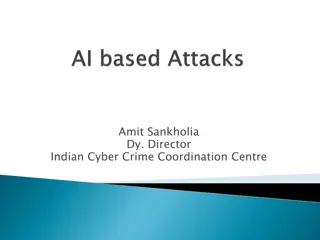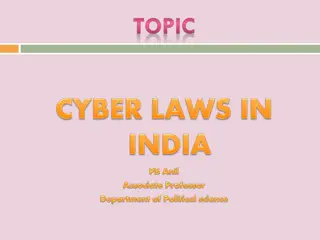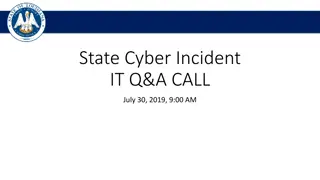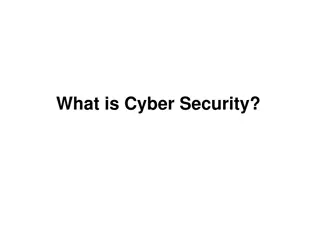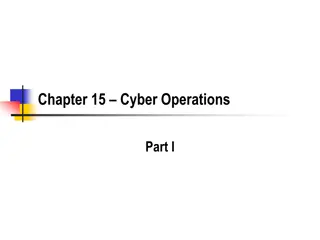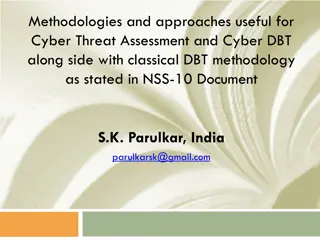Impact of Cyber Crime Surge During COVID-19 in India
The COVID-19 era in India saw a significant rise in cyber crimes, affecting individuals and institutions across the country. With the shift to digital platforms, cyber frauds and attacks skyrocketed, posing new challenges amidst a global pandemic.
Download Presentation

Please find below an Image/Link to download the presentation.
The content on the website is provided AS IS for your information and personal use only. It may not be sold, licensed, or shared on other websites without obtaining consent from the author.If you encounter any issues during the download, it is possible that the publisher has removed the file from their server.
You are allowed to download the files provided on this website for personal or commercial use, subject to the condition that they are used lawfully. All files are the property of their respective owners.
The content on the website is provided AS IS for your information and personal use only. It may not be sold, licensed, or shared on other websites without obtaining consent from the author.
E N D
Presentation Transcript
COVID-19 AND CYBER CRIME IN INDIA Name : Munis Nasir Position: Intern at Centre for legal research and foreign and public policy (clrfpp)
ISSUES DISCUSSED How cyber crimes were increased during COVID-19 era? Emerging forms of cyber crimes in India?
WHAT IS CYBER CRIME ? Electronic form of crime Computer oriented crime Data theft Hacking Identity theft Phishing . Thus, cyber crime is any sort of illegal activity involving a computer network or any digital network.
CYBER CRIME IN INDIA The 20th century has bombarded us with new age of technology, where digital technology has interlocked industries, economies, trends and also us. However the progress had rapidly flourished, it made us all a slave of technology. In 2018, the report stated about 400 million internet users in India. Thus making it the second-largest internet population in the world. But one aspect which needs to be taken into consideration is that with greater progress, the evolving societies open gates for many unpredictable vulnerabilities. With daily progress in technological inventions, the risk of getting trapped under a cyber crime is always there.
CYBER CRIME IN INDIA Some important figures which will give a brief outlook of cyber crimes are: 1. Number of cyber frauds in 2018 3353 2. Value of Bank Frauds in Financial Year 2019 715bn INR 3. Number of ATM frauds in 2018 1284 4. Number of people arrested for cyber crimes in 2018 13,569 SOURCE: (https://www.statista.com/topics/5054/cyber-crime-in-india/)
COVID-19 ERA AND CYBER CRIME The beginning of 2020 marks the beginning of a new sort of disease named COVID-19 which destroyed many lives internationally. In India, 24th March 2020 marked the first date of nation wide lockdown. Since then the COVID virus spread across very rapidly and making India as the first four countries of most cases. Coronavirus induced lockdown was not a relief time for the people. Certain events like displacement of migrant workers, job losses of people and economies went down.
COVID ERA AND CYBER CRIME With these problems during the pandemic lockdown, students on one side were made to attend online classes and on other side other sections of society were made to work from home. Since most work was made on a digital basis, the street crime rate went down. But increase in cyber crimes went up. Between March and April 2020, India witnessed a staggering 86% increase in cyber-attacks. According to the UN Special Rapporteur, women are both disproportionately targeted by online violence and suffer disproportionately serious consequences as a result. According to the India Internet 2019 report, by the Internet and Mobile Association of India (IAMAI), a large gender disparity is visible, with the number of female internet users being approximately half of the 258 million male Internet users in the country. SOURCE: (https://ciso.economictimes.indiatimes.com/news/cyber-crime- trends digital safety amidst covid 19 pandemic/75934732)
WORK FROM HOME AND CYBER CRIME Working from home (WFH) has become the priority during the coronavirus lockdown. The way of working in a whole has drastically changed, while it established an ease. How does work from home resulted to increase in cyber crime? In order to accomplish the tasks digitally, the population adjusted themselves. While accomplishing the tasks, online traffic has been on a high through video conferencing, meetings, classes etc. The apps for transfer of money like Paytm, Google Pay etc. was also witnessed a surge. These platforms served as a stage for criminal elements. These opportunities evolved as a perfect stage for cybercriminals to exploit the people through many means.
EMERGING FORMS OF CYBER CRIMES Recent statistics spoke a lot of increase in the number of cyber crimes. So some forms of cyber crimes are: 1. Phishing: cyber crime where the criminal gets into deep access of the information and details of the user through a link or e-mail that seems to be licit but in reality is not. Spyware and ransom attacks are some of the phishing techniques posing a threat to people submitting their information online. 2. Hacking at Companies and Offices: Since companies and offices holds some credential information about its employees and other information it becomes important for it to maintain a privacy. So companies have to set up a VPN structure, so that only the employees will have the access to the company s information. SOURCE: (https://www.latestlaws.com/articles/growth-in-cyber-crimes-in-the- covid-19-times-and-fragile-cyber-laws-in-india/)
EMERGING FORMS OF CYBER CRIMES 3. Hacking at hospitals: So the COVID-19 lockdown gave a different view that hacking is not restricted to companies but to hospitals too. The cyber attacks had not only been there at local hospitals or test centres but also at WHO for the motive to steal the passwords of WHO workers. 4. Cyber crimes in social media platform: Social networking sites have resulted in spreading of fake news propaganda instantly. These sites have witnessed many people to burden their real voices and follow the fake news. SOURCE: (https://www.latestlaws.com/articles/growth-in-cyber-crimes-in-the- covid-19-times-and-fragile-cyber-laws-in-india/)
EXISTING CYBER LAWS IN INDIA Information Technology is the only prevalent law all over India providing for the offences of cyber world and accordingly the punishments and remedies. Some of the offences defined under IT Act, 2000: 1. Section 66E violation of privacy 2. Section 66F Punishment for cyber terrorism Section 43 hacking (damage of the computer system without the permission of the owner) Section 72 Penalty for breach of confidentiality and privacy (imprisonment extend to 2 years or fine extends to 1 lakh rupees or both) 5. Section 66 computer related offences person dishonestly or fraudulently punishment extend to 3 years or fine extends to 5 lakh rupees or both. 3. 4.
EXISTING CYBER LAWS IN INDIA Apart from the IT Act, 2000 Indian Penal Code 1860 provides for the punishments and remedies of cyber crimes: Some of the offences defined under IPC 1860 are: Section 419 IPC Punishment for cheating by personation extend to 3 years or fine or both 2. Section 354C Voyeurism 3. Section 354D - Stalking 4. Section 505 IPC publish or circulation of fake news propaganda 1.
TYPES OF CYBER BULLYING Posting or spreading hateful and humiliating rumours Publication or circulation of embarassing or inappropriate photos and videos Impersonating someone by creating a fake social media profile or webpage and sharing real or fabricated information Instigating religious, ethnic or political hate by spreading hateful posts 5. Threatening to commit acts of violence Stalking someone digitally and sending offensive and abusive messages to scare, harm and intimidate him/her. 1. 2. 3. 4. 6.
WAY AHEAD TO DEAL 1. Do not respond: One of the key things one can do is stop responding to strangers. Blocking any such advancements primarily, will save an individual from a lot of abuse. Report on the Platform: Each social media platform have the feature of reporting any inappropriate stuff on the platform. This feature provides a safety and trust to the user. Stop sharing your personal data: An individual should not share their password with anyone. Since cyber space cannot be defined in particular, the risk of getting trapped is always high. 2. 3.
CONCLUSION The dangers involved with the cyber crime have been prevalent for many years, but the direct risk of getting trapped in a cyber-crime activity is proportional to the increase in the population connected to the internet and the time spent online.



